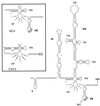Vitamin B12 and hepatitis C: molecular biology and human pathology
- PMID: 11296247
- PMCID: PMC33138
- DOI: 10.1073/pnas.081072798
Vitamin B12 and hepatitis C: molecular biology and human pathology
Abstract
Cobalamins are stored in high concentrations in the human liver and thus are available to participate in the regulation of hepatotropic virus functions. We show that cyanocobalamin (vitamin B12) inhibited the HCV internal ribosome entry site (IRES)-dependent translation of a reporter gene in vitro in a dose-dependent manner without significantly affecting the cap-dependent mechanism. Vitamin B12 failed to inhibit translation by IRES elements from encephalomyocarditis virus (EMCV) or classical swine fever virus (CSFV). We also demonstrate a relationship between the total cobalamin concentration in human sera and HCV viral load (a measure of viral replication in the host). The mean viral load was two orders of magnitude greater when the serum cobalamin concentration was above 200 pM (P < 0.003), suggesting that the total cobalamin concentration in an HCV-infected liver is biologically significant in HCV replication.
Figures







Similar articles
-
Differential effects on the hepatitis C virus (HCV) internal ribosome entry site by vitamin B12 and the HCV core protein.J Virol. 2004 Nov;78(21):12075-81. doi: 10.1128/JVI.78.21.12075-12081.2004. J Virol. 2004. PMID: 15479850 Free PMC article.
-
Vitamin B12 stalls the 80 S ribosomal complex on the hepatitis C internal ribosome entry site.J Mol Biol. 2002 May 24;319(1):1-8. doi: 10.1016/S0022-2836(02)00300-5. J Mol Biol. 2002. PMID: 12051931
-
Interferons specifically suppress the translation from the internal ribosome entry site of hepatitis C virus through a double-stranded RNA-activated protein kinase-independent pathway.J Infect Dis. 2002 Jul 15;186(2):155-63. doi: 10.1086/341467. Epub 2002 Jul 3. J Infect Dis. 2002. PMID: 12134250
-
The hepatitis C virus internal ribosome-entry site: a new target for antiviral research.Biochem Soc Trans. 2002 Apr;30(2):140-5. Biochem Soc Trans. 2002. PMID: 12023841 Review.
-
The hepatitis C virus life cycle as a target for new antiviral therapies.Gastroenterology. 2007 May;132(5):1979-98. doi: 10.1053/j.gastro.2007.03.116. Gastroenterology. 2007. PMID: 17484890 Review.
Cited by
-
COVID-19's toll on the elderly and those with diabetes mellitus - Is vitamin B12 deficiency an accomplice?Med Hypotheses. 2021 Jan;146:110374. doi: 10.1016/j.mehy.2020.110374. Epub 2020 Nov 12. Med Hypotheses. 2021. PMID: 33257090 Free PMC article. Review.
-
Association of serum vitamin B12 levels with stage of liver fibrosis and treatment outcome in patients with chronic hepatitis C virus genotype 1 infection: a retrospective study.BMC Res Notes. 2015 Jun 25;8:260. doi: 10.1186/s13104-015-1248-z. BMC Res Notes. 2015. PMID: 26109044 Free PMC article.
-
New opportunities for designing effective small interfering RNAs.Sci Rep. 2019 Nov 6;9(1):16146. doi: 10.1038/s41598-019-52303-5. Sci Rep. 2019. PMID: 31695077 Free PMC article.
-
Inhibition of hepatitis C virus IRES-mediated translation by small RNAs analogous to stem-loop structures of the 5'-untranslated region.Nucleic Acids Res. 2004 Mar 12;32(5):1678-87. doi: 10.1093/nar/gkh328. Print 2004. Nucleic Acids Res. 2004. PMID: 15020704 Free PMC article.
-
The Role of Micronutrients in the Infection and Subsequent Response to Hepatitis C Virus.Cells. 2019 Jun 17;8(6):603. doi: 10.3390/cells8060603. Cells. 2019. PMID: 31212984 Free PMC article. Review.
References
-
- Choo Q L, Kuo G, Weiner A J, Overby L R, Bradley D W, Houghton M. Science. 1989;244:359–362. - PubMed
Publication types
MeSH terms
Substances
LinkOut - more resources
Full Text Sources
Other Literature Sources
Medical
Miscellaneous

